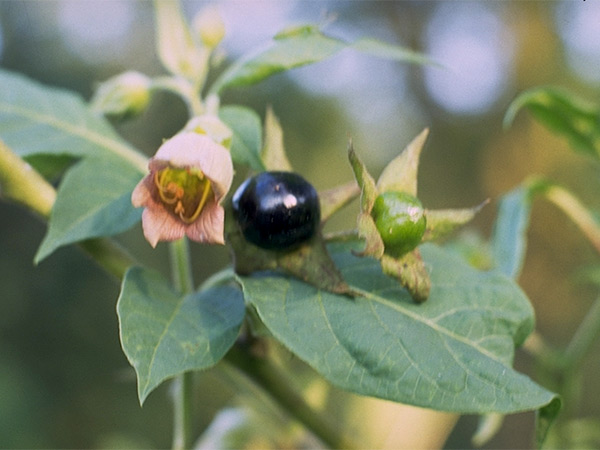Botanical name
Atropa bella-donna L.
Family
Solanaceae
Common name
Deadly nightshade, Belladonna, Devil’s Cherries
Information about the plant
Belladonna is a poisonous plant (!) native to Europe, it is also found in Asia eastward to the Himalayas and in Mediterranean Africa. In Germany, it grows in the southern and central parts, although it is absent in northern Germany. It grows in deciduous forests, forestry slash, and on forest edges.
The name "belladonna" refers to the effect of the cherry-like black and shiny fruits. When eaten, they cause symptoms similar to rabies, firstly a general excitement which increases to a strong euphoria with hallucinations but also to crying fits, always combined with a strong urge to move up to fits of raving madness. Death by respiratory paralysis. Because of its inevitably fatal effect, the plant has received a generic name of the goddess of fate Atropos (The Inevitable). In Greek mythology, she cuts the thread of life. The species epithet bella-donna, which translates as "beautiful woman", refers to the pupil-dilating effect of the tropane alkaloids contained in all parts of the plant. Thus, even just rubbing the eyes after touching the plant, and certainly when eating the cherries, can significantly dilate the pupils, which is very flattering for a woman. Allegedly, women used to drip the berry juice into their eyes for a more attractive appearance.
Belladonna is perennial, grows up to 1.5 m high with wide spreading branches. The leaves can reach up to 20 cm in length, and from each leaf axil grows a long-stemmed flower. The flowers sit in a 5-lobed calyx, they are 5-lobed bell-shaped, purple-brown on the inside and light brown on the outside. The fruit is a black, very shiny berry the size of a cherry, surrounded by a star-shaped calyx. Its cherry-like appearance, shine and its sweet taste are very attractive to children (caution poisonous effect, see above); 3 to 4 berries are considered fatal in children. Flowering time is June/July, and fruit ripening is in September.
Medicinally used parts of plants (herbal drug)
The dried leaves or the dried leaves with flowering and occasionally fruit-bearing branch tips (belladonna leaves - Belladonnae folium) are used. The commercially available drug comes from cultivations in various European countries.
Constituents of the herbal drug
Belladonna leaves contain potent tropane alkaloids, the most important of which are L-hyoscyamine, atropine (the racemate of L-hyoscyamine), scopolamine, and belladonnine; also flavonoids and coumarins. The tropane alkaloids are responsible for the plant’s toxicity.
Quality of the drug
The quality of the following drugs or drug preparations is specified in the European Pharmacopoeia (Ph. Eur.):
- Belladonna leaves (Belladonnae folium)
- Standardized belladonna leaves dry extract (Belladonnae folii extractum siccum normatum)
- Standardizes belladonna powder (Belladonnae pulvis normatus)
- Standardized belladonna leaves tincture (Belladonnae folii tinctura normata)
Medical applications
Recognised medical use
In the past, belladonna leaves and belladonna leaves preparations were used for cramps and colic-like pain affecting the gastrointestinal tract and bile ducts. Due to the narrow therapeutic range (strong poisonous effect of the tropane alkaloids!), this is problematic and should no longer be practised. Belladonna leaves and their isolated alkaloids (hyoscyamine, atropine) are potent drugs and should not be used phytotherapeutically. For this reason, neither the HMPC nor the ESCOP have processed belladonna leaves.
Traditional use
Due to the content of highly active alkaloids, belladonna leaves cannot be classified as a traditional herbal medicinal product within the meaning of § 39a AMG.
Herbal drug preparations in finished dosage forms
None; the atropine isolated from belladonna leaves is used in the form of atropine sulphate in ophthalmology as a mydriatic, i.e., to dilate the pupils for ocular fundus examinations.
Dosage
Not applicable
Preparation of a tea
Not applicable
Notes
Belladonna leaves are toxic (strong central effect!), therefore, the use of the drug or finished medical products should only be considered under the supervision of a doctor.
Children and adolescents under 18 years of age should not use belladonna leaves.
Further literature
Commentary on the European Pharmacopoeia (Belladonna Laves, Nr. 0221; Standardized Belladona Leaf Dry Extract, Nr. 1294; Standardized Belladonna Powder, Nr. 0222; Standardized Belladonna Leaves Tincture, Nr. 1812)


